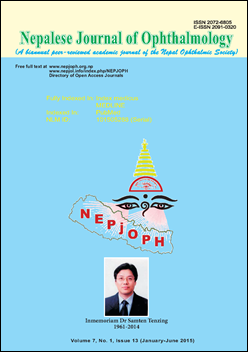Characteristic of low vision patients attending an eye hospital in eastern region of Nepal
DOI:
https://doi.org/10.3126/nepjoph.v7i1.13164Keywords:
blindness, low vision, optical devices, visual impairmentAbstract
Introduction: Low vision is an important public health problem.
Objective: To study the profile of low vision patients in a hospital of Nepal.
Materials and methods: Information related to the patients’ profile, visual status, ocular disease and, low vision devices prescribed were obtained retrospectively from the records of 1,860 visually- impaired patients, regardless of the cause, presenting to the low vision department of the Biratnagar Eye Hospital, Biratnagar, Nepal, over a period of four years. These patients, after a comprehensive ocular examination, underwent low vision examination by an ophthalmologist and a low vision specialist.
Results: Of 1,860 patients, males comprised 1298 (70 %), while 562 (30 %) patients were female. Six hundred and one (32.3%) patients were of less than 20 years while 398(21.4%) were more than 60 years of age. Agriculture (500, 27 %), household work (341, 18 %) and students (308, 17 %) were the common occupations. Retinal diseases were the commonest cause of low vision. They were: macular disorders 408 (22 %), retinitis pigmentosa 226 (12.1 %) and other retinal causes 361 (19.4 %) (diabetic retinopathy, choroidal coloboma, post laser for retinal vasculitis and central retinal/branch retinal vein occlusion, healed macular chorioretinal scar secondary to retinochroiditis and choroiditis). Refractive error 215 (11.5 %), amblyopia 49 (2.6 %), optic atrophy 144 (7.8 %) and microphthalmos 105 (5.6 %) were the other causes. Uncorrected distance visual acuity was between 6/24 and 6/60 in 509 (27.4 %) and between 5/60 and PL in 1,327 (71.3 %) patients. Similarly, near visual acuity with vision better than 2.50 M (N 20) and worse than 2.50M (N20) was present in 643(34.5%) and 1,217(65.5%) patients. About 67% and 54.5% of the patients had some improvement in their distance and near visual acuity with glasses and low vision aids. Distance spectacles 909 (49 %), near spectacles 106 (5.7 %), hand held magni¿ers 78 (4 %) and telescopes 18 (1 %) were the optical devices prescribed.
Conclusion: The prevalence of low vision is common among the people of the younger and older age groups. Retinal diseases are common among the causes for low vision. Adequate prescription and availability of low vision devices can improve the visual acuity.
Downloads
Downloads
Published
How to Cite
Issue
Section
License
This license enables reusers to copy and distribute the material in any medium or format in unadapted form only, for noncommercial purposes only, and only so long as attribution is given to the creator.




